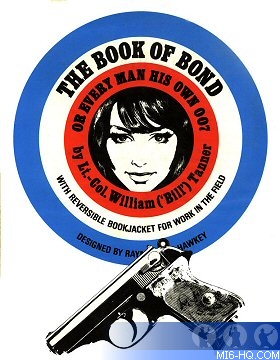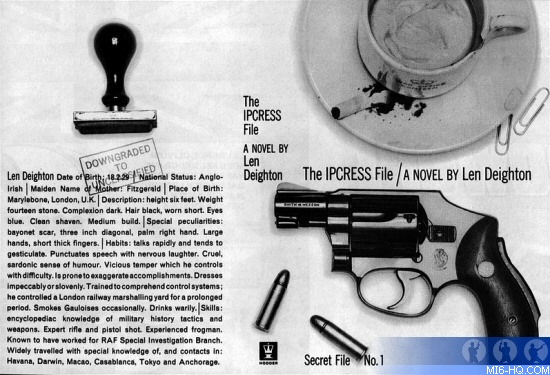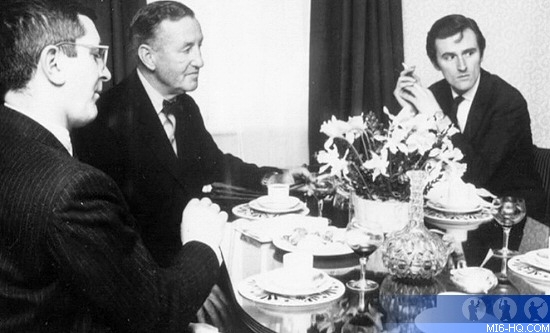 |
| |
Illustrious graphic artist and thriller writer
Raymond Hawkey, who designed the first James Bond
paperback series for Pan, has died aged 80...
|
|
Raymond Hawkey (1930-2010)
24th August 2010
Raymond Hawkey was a illustrious
trend-setting graphic designer who designed newspapers, magazines,
book covers and even film
credits sequences. He also produced four thriller novels. His
style revolutionized British design in the 1960s at the height
of spy-fever. Raymond (Ray) Hawkey was born in 1930 in Portsmouth,
England. Hawkey was an only child, and his father (who worked
as a commercial
traveler) encouraged him to become an accountant. But after
discovering a natural talent for drawing, Hawkey earned a scholarship
for grammar school where his headmaster directed him towards
the Plymouth School of Art, where he went on to achieve a National
Diploma in Design. He also won a scholarship in 1950 to study
at the Royal College of Art where he became a notable art director
of the RCA's ARK magazine.
|
Whilst studying at the Royal College of
Art (RCA), Hawkey assisted the picture editor of the English
tabloid newspaper 'The Sunday Graphic' and won a design
talent competition held by Vogue magazine. He was quickly
recruited by Vogue's publishers Condé Nast where
he worked as art director of magazine promotion for three
years.
Hawkey then moved back in to newspapers,
becoming the design director of the Daily Express in 1959
- the paper in which James
Bond had made his comic strip debut a year previous.
His work with Michael Rand to revitalize
the use of illustration at the Express won much critical
praise. The same year, Hawkey was one of the founders
of
the Association of Graphic Designers.
Back in his RCA days, Hawkey first encountered
Len Deighton when Deighton (another RCA scholarship
student at that time) gate crashed a literary party that
Hawkey was helping to organize. Instead of ejecting the
intruder, Hawkey found much in common with him and they
became lifelong friends. |
|

Above: 'The Book of Bond' (1965)
by Kingsley Amis, designed by Raymond Hawkey.
|
In 1962, Hawkey was Deighton's choice to design
the cover of his first novel The IPCRESS File, which revolutionized
jacket
design. It shows a snub-nosed revolver lying next to a grimy
coffee cup with a cigarette stub squashed out on the saucer.
Between the two items are a bullet and a pair of paperclips,
similar in outline, utterly divergent in purpose. Deighton's
publisher Hodder had doubts, but the two creatives held their
ground and history was made, and the first print run sold out
within 24 hours. Deighton negotiated to have Hawkey's fee increased
to £50, which he split with Daily Express news photographer
Ken Denyer.

Above: Raymond Hawkey's groundbreaking
cover for "The IPCRESS File".
|
The Guardian described Hawkey's work for Deighton as "simple,
close-cropped, photographically based covers that became a template
for all airport novels." He went on to design further covers
for Deighton's books, including Horse Under Water, Funeral in
Berlin and The Action Cookbook (where the IPCRESS revolver reappears,
this time with a sprig of parsley in the barrel).
Deighton's best-selling novel got the attention
of Pan, who were about to publish the James
Bond novels in paperback. Pan
had first been tipped to Hawkey's work by Bond producer Harry
Saltzman, who told the chairman of Pan Books that they needed
a vibrant design. Hawkey was hired to produce a set of visually
striking covers for Ian
Fleming's adventures in the mid-to-late
1960s. Hawkey had known Ian
Fleming, but it would be ten years
after the death of 007's creator before Hawkey would pen his
own thriller. Hawkey had a long-lasting effect on the Bond novels
after his Pan series was published, as he was the first to propose
that 'James Bond' be placed above the novel's title, and that
the lettering should be double the size.
Above: The Pan 1963
paperback covers for Thunderball and On
Her Majesty's Secret Service. The Hawkey-designed covers would run
from 1st printing on 3rd May 1963 through to their 12th
edition in 1965. They are widely regarded as the most
successful series of republished James Bond novels. |
"Previous Bond covers
had been illustrative, nicely painted but not exactly stylish.
Subsequent covers would accentuate the guns,
gadgetry and glamorous girls but little else. The Pan covers
[by Hawkey] have a stark elegance, and are consistently menacing
and memorable. Each has a single photographic image on a plain
or textured background. Blurb is dispensed with. It’s the
visual equivalent of a cruel, sardonic smile. Raymond Hawkey’s
Bond covers share [The IPCRESS File's] minimalist aesthetic, although
of course there are no grimy coffee
cups in the world of Ian Fleming’s super-spy.
For Thunderball, Hawkey
fills the cover with a close-up of a man’s naked back, perforated by two bullet holes. These
are actual holes, die-cut into the card. Surrounding each is
a torn-paper effect. It’s not the man who has been shot,
it’s the book – and, as proof, the bullets can be
found inside, depicted on the opening page. Bond’s life
is so dangerous, this cover tell us, even books about him aren’t
safe. Read on if you dare.
Interestingly, the Thunderball
book is the only one where Hawkey is credited on the back.
Its cover is the best of an outstanding
set of images and the acknowledgement of the designer suggests
the publisher thought so too."
- The Financial
Times, March 8th 2008

Above (Left to Right): Len Deighton,
Ian Fleming and Raymond Hawkey.
|
Other authors that had jackets designed by Hawkey
include Kingsley
Amis (Hawkey designed 'The Book of Bond'), Jane Gaskill,
Thomas Hinde, Gavin Lyall, Frederick Forsyth and others. Hawkey's
photo-realistic cover style is also seen in his title sequence
for Richard Attenborough's 1969 film "Oh! What a Lovely
War" for which Len Deighton was screenwriter and an (uncredited)
producer.
Hawkey was appointed presentation director of The Observer newspaper
in 1964 and lead the design of its colour magazine, where he
worked until 1975. In July 1986 he was co-designer (with Tony
Mullins) of the first dummy of The Independent, but it is not
clear how much of his contribution survived the painful cycles
of redesign before its eventual launch.
Hawkey also wrote four well-received thriller
novels "Wild
Card" (with Roger Bingham) in 1974, "Side-Effect" in
1979, "it" in 1983 and "End Stage" in 1988.
His friend Deighton described Side-Effect as "compulsively
readable, brilliantly researched and chilling as tomorrow's headlines".
Raymond Hawkey died in late August 2010 at the age of 80. He
had lived in Notting Hill, London for 40 years. In his seventies,
he was penning a new novel and worked occasionally as an editorial
consultant, in between trips to his second home in Brighton.
He is survived by his wife Mary, who he married 21 years ago.